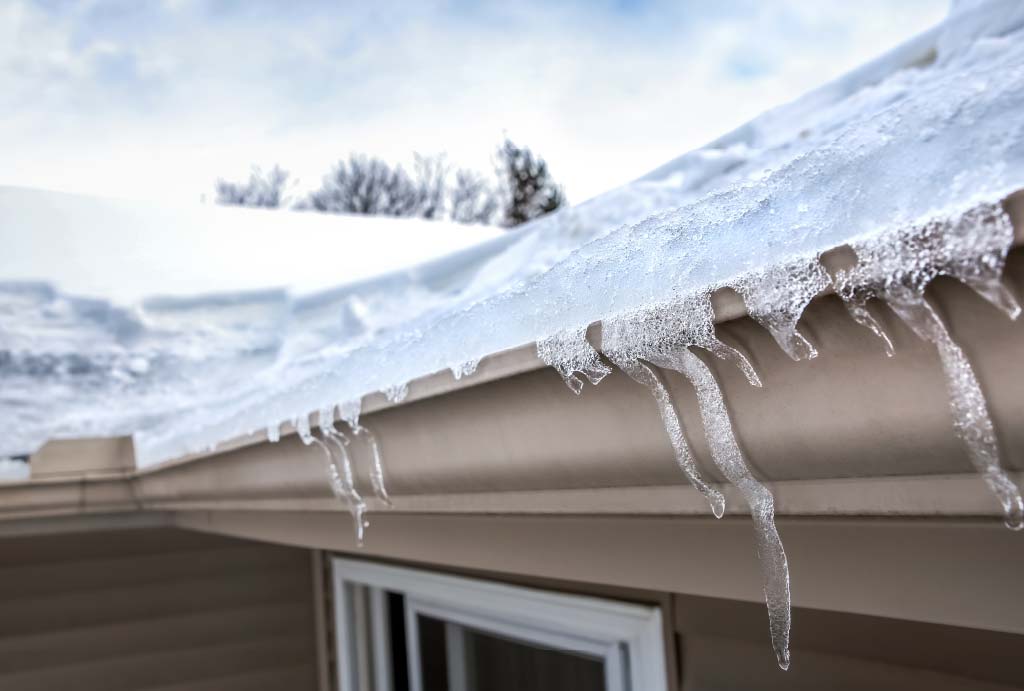Winter in Indianapolis can look beautiful —snowy rooftops, frosted lawns, and icicles glinting in the sunlight. But behind that postcard scene is a real danger many homeowners don’t think about until water shows up on the ceiling: ice dams and winter roof leaks. We build, repair, and protect roofs across Indy, so we see the damage up close. This guide explains what ice dams are, why they form, and practical, 2025-ready steps you can take to stop leaks before they start. We’ll also explain what we at Stay Dry Roofing do differently to keep your home dry.
What is an ice dam and why should you care?
An ice dam forms when warm air from your home melts the snow on the upper part of your roof. That meltwater flows down, refreezes at the colder eaves, and creates a ridge of ice that blocks drainage. When the dam grows, water backs up under shingles and can leak into ceilings and walls. Left unchecked, this leads to rotten decking, damaged insulation, mold growth, and costly emergency repairs. That’s why understanding the basics matters.
The root cause: heat where it shouldn’t be
Ice dams are a symptom, not the disease. The real problem is heat loss through the ceiling and into the attic. When your attic is warmer than the outside air, snow melts unevenly. Fix the heat transfer and you dramatically reduce ice-dam risk. That means two engineering basics: insulation and ventilation done right. Local roofing pros in Indianapolis, including restoration specialists, recommend improving both before winter hits.
Five practical prevention steps Indianapolis homeowners can take in 2025
1) Inspect and upgrade attic insulation
Think of insulation as a thermal blanket for your roof. If your attic floor has gaps or old, compressed insulation, warm air will rise and warm the roof deck. Adding insulation to reach recommended R-values (and making sure it’s installed continuously and without gaps) keeps the heat where it belongs inside your living space. For many older Indy homes, a focused insulation upgrade is the most cost-effective first step.
2) Improve attic ventilation. Balance intake and exhaust
Ventilation keeps attic air close to outdoor temperature. You need a good path for cool air to enter at the soffits and exit at the ridge (or other high points). That steady exchange prevents pockets of warm air from forming under the roof. If your attic has blocked soffits, undersized vents, or poor exhaust, add or rebalance vents rather than simply cranking up insulation. A combined insulation + ventilation plan is the long-term fix.
3) Seal air leaks. Stop heat before it reaches the attic
Even a tiny gap around a chase, attic hatch, recessed light, or plumbing stack can leak warm air into the attic. Seal those leaks with caulk, foam, or gasketing. Pay attention to attic access doors and recessed fixtures in the ceiling; these are common culprits. Sealing leaks is inexpensive and the payoff is immediate: less heat transfer, less roof melt, fewer ice dams.
4) Keep gutters and downspouts clean and clear
Blocked gutters mean meltwater can’t escape, which worsens ice buildup. Clean gutters in fall and again if heavy leaf drop happens before the first heavy snow. Consider a pre-winter gutter health check and if your gutters frequently clog, talk to us about better guards and downspout routing. Proper drainage is a simple step that prevents many leaks.
5) Remove snow safely; use calcium chloride channels if needed
When heavy snow accumulates, removing a 3–4 foot band of snow from the roof edge keeps water from pooling above the eaves. Use a long-handled roof rake from the ground, never climb on an icy roof. If an ice dam already exists, a calcium chloride sock (a stocking filled with ice-melt placed across the dam) can safely create a drainage channel. For active ice dams or risky situations, hire professionals who use low-pressure steam or other safe tools rather than hammers or hatchets.
Product-level protection: Ice & Water Shield and modern underlayments
You can take all the attic and gutter steps and still want additional protection, especially if your roof is older or you live on a windy, exposed lot. Ice & Water Shield (a self-adhering, rubberized membrane) is installed in critical areas eaves, valleys, around chimneys and skylights to block meltwater that backs up under shingles. In 2025, higher-performance membranes and synthetic underlayments are standard on smart roof builds because they stop leaks when weather tries to force water into weak spots. We recommend installing membrane in recommended zones during a reroof or targeted repair.
De-icing cables: when they help and when they don’t
Heated cables can clear small sections of eaves and gutters. They’re not a substitute for fixing insulation/ventilation problems, but they are useful on trouble spots, for example, over a dormer or a long valley where access for snow removal is limited. If you choose cables, have them installed by a pro and follow manufacturer guidelines; improper installation can create other issues.
When to call Stay Dry Roofing and what we do differently
If you notice recurring leaks, long icicles, wet attic insulation, or stains along the ceiling, call us. We’ll do a thorough inspection of roofing materials, underlayment, flashing, gutters, attic insulation, and ventilation. Typical Stay Dry repairs include:
- Localized Ice & Water Shield installation where leaks are likely.
- Targeted attic air sealing and insulation upgrades (we work with insulation pros where needed).
- Safe, ground-level snow removal when the roof is at risk, using equipment and techniques designed to protect shingles and gutters.
- Professional ice-dam removal (steam or controlled melt) rather than risky, destructive DIY tactics.
We document our work, explain every item on your estimate, and look for the cost-effective combination of repairs that will stop leaks not just treat symptoms.
Quick checklist you can use this winter
- Check attic insulation depth and continuity.
- Inspect soffits and ridge vents; ensure nothing blocks airflow.
- Seal gaps around attic penetrations and hatch doors.
- Clean gutters and confirm downspouts discharge away from foundation.
- Keep a roof rake handy and remove edge snow after heavy storms.
- If an ice dam forms, call pros for safe removal avoid chiseling or salt that damages roofing.
Common homeowner myths busted
Myth: “Putting heat cables on the whole roof is the fix.” Not true. Cables are a tool, not a cure. Fix attic heat control first
Myth: “My roof is new, so ice dams won’t be a problem.” New shingles won’t stop meltwater that runs under flashings and into the decking. Proper membrane and attic control matter.
Cost perspective: spend a little now, save a lot later
A modest investment in insulation, ventilation, or ice-and-water barrier often avoids emergency repairs, ceiling replacements, or mold remediation. In many Indianapolis projects we do, the combined cost of targeted attic upgrades and membrane installation is small compared with a single winter leak and a full interior repair. We’ll give you a transparent, line-item estimate so you can weigh options.
Final thoughts from Stay Dry Roofing
Indianapolis winters don’t have to mean roof panic. Start with the attic: seal, insulate, and ventilate. Keep gutters clear. Remove roof-edge snow safely. Use Ice & Water Shield where it matters. And when you need help, call licensed pros who prioritize safe removal and lasting fixes. We are local, we know Indy’s weather patterns, and we’ll work with you to stop leaks before they start.
If you suspect a leak, see long icicles, or want a winter-ready inspection, reach out to Stay Dry Roofing. We’ll inspect, explain, and protect your home no scare tactics, just honest, local roofing work.


